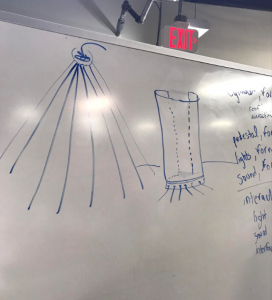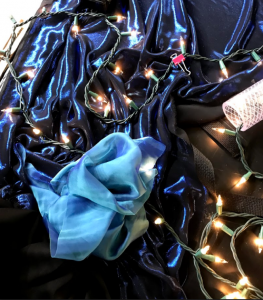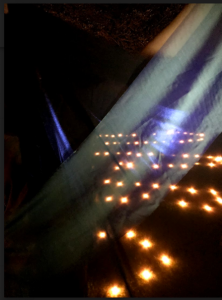This week we started building and testing around our how can we statement: how can we help the Rice community become more aware of their water consumption through an installation art piece at the Solar Studios?
Through our past phases of the design process we isolated the insight that our water footprint is much larger than the direct water consumption we are aware of. Though we may not be able to always see that water footprint, others can when it impacts the larger system.
With this in mind, we plan to build an art instillation at the Solar Studios that illustrates this concept with the use of LED lights to represent water.
Our instillation will include a cylinder like structure with a glowing bottom pedestal that visitors will step in to. When inside this structure their vision of the light array extending from the cylinder will be obscured. The lights extending on the ground from the structure which were previously lighting up in a way that mirrors a calm flow of water will now become turbulent, in a way visitors outside the cylinder will witness.
As an art instillation, we understand not every visitor will immediately understand the message of the instillation, but our goal is that they do feel an “aha” or “oh” moment at the instillation, and with an informational plaque or brochure will connect to the larger message.
With this goal in mind, as well as the fact that we hope to have some fidelity of a physical instillation up at the end of the semester, the two assumptions we needed to test was:
- Does this instillation make sense and connect with individuals outside our team?
- Is this instillation feasible to construct in our time frame?
We tested these assumptions first through conversations. We discussed the instillation with another DFA team and gathered their feedback on their understanding of the instillation. We then contacted fellow members and students with knowledge of light programming to get their insight. We also went shopping! We bought a number of pipe like materials and fabrics to help start testing ideas of our cylinder as well as borrowed lights to test that concept.
We met with Rob Purvis, manager at the Moody Shop to test our assumptions about construction feasibility and got a lot of great feedback and resources and validated our belief that our instillation is feasible to construct.
Finally, we tested both feasibility and the impact of our concept by visiting the site of the Solar Studios, discussing the instillation with artist and project mentor Lina Dib, and Solar Studios Technical Advisor Taylor Knapps, before testing lights at the site.
With this testing and feedback we now know our instillation is feasible and connects with the individuals we spoke to.
Our next steps include budgeting and purchasing materials and continuing to build a higher fidelity prototype!



